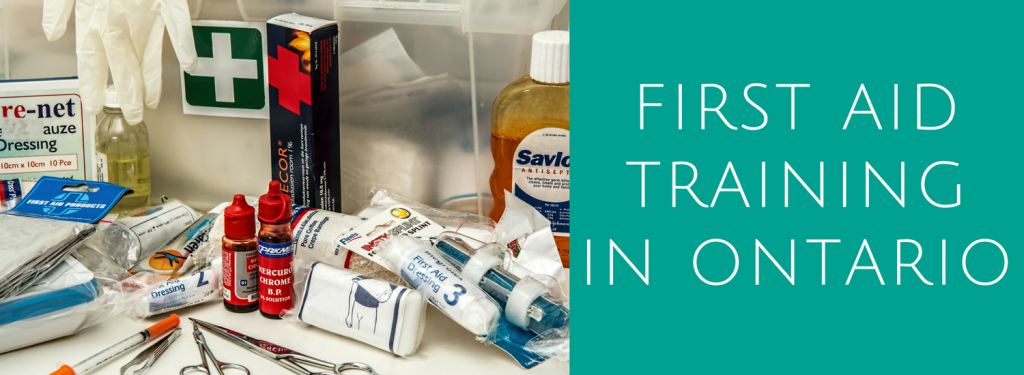
According to the Ontario Ministry of Labour, Immigration, Training and Skills Development, Ontario workplaces covered by the Workplace Safety and Insurance Act, 1997 must have first aid equipment, adequate facilities, and first aid trained staff. Specific first aid training requirements, as well as additional required training, depend upon the work environment. For example, those working on construction projects must take a Working At Heights course as well as additional first aid training. For more information about health & safety training, contact the experienced trainers at ACUTE today!
About First Aid Training

Though there are different types, first aid training courses focus on treating injury and illness, from minor scrapes and cuts to more serious illnesses or injuries such as broken bones. The amount of first aid training an employee receives depends on their workplace role as well as the workplace requirements set out by various government regulations and legislation. Workers can take first aid training alone, though many first aid courses often include or accompany CPR training. However, keep in mind that CPR training is not equivalent to first aid training. The WSIB First Aid Requirements Regulation 1101 states that first aid includes (but is not limited to):
- Minor cuts
- Minor scratches or scrapes
- Treating a minor burn
- Applying bandages, dressings, or cold compresses
- Changing a bandage
- Applying a splint
- Any follow-up or observation after an injury
Check out the short video below to see the kind of training and information you will receive during a first aid/CPR class.
Employer Responsibilities

Under the WSIB First Aid Requirements Regulation 1101, employers have many responsibilities that include ensuring employees are treated with appropriate first aid immediately. Employers must also:
- Keep a record of any accident/injury and first aid treatment or advice given
- If the worker needs more than just advice or first aid, the employer must complete and provide the worker with the Treatment Memorandum Form 156
- Immediately provide transportation to the hospital, a doctor’s office, or the worker’s home if necessary
- Click here to read all employer responsibilities
Employee Responsibilities

Just like under the Ontario Health & Safety Act (OHSA), both employers and employees have responsibilities in the workplace. Employers are responsible for the safety of their workers. However, employees are also responsible for complying with health and safety guidelines. Under the WSIB First Aid Requirements Regulation 1101, employees must:
- Seek first aid treatment immediately when necessary
- Inform the employer about any injury or the possibility of a work-related disease/condition
- Claim benefits if their injury required the employee to seek health care
- Click here to read all employee responsibilities
First Aid Training Courses
Depending on workplace requirements, you may have to take one or many different first aid training courses, including or excluding CPR training. Below we outline some of the most common first aid training courses that you may come across when searching for the right first aid training course for you, your workplace, or your employees. A good first aid course and trainer will comply with the Canada Labour Code and WSIB requirements. You can find WSIB approved training providers here!
Basic/Standard First Aid

Standard or basic first aid training is one of the most common types of first aid training courses. These courses will outline all the essentials and almost always include CPR training. Standard first aid classes in Ontario are usually two days long. During a basic first aid & CPR course, participants usually learn through classroom instruction as well as hands-on scenarios.
Emergency First Aid

Emergency first aid courses are usually shorter than basic first aid – typically only lasting one training day. The exact amount of time varies. Emergency first aid courses usually have a stronger focus on CPR and other life-saving techniques that would be used in more serious scenarios. Emergency first aid courses are also highly interactive and usually provide participants with hands-on, practical simulations as well as classroom interactions.
Mental Health First Aid

Mental health first aid training courses are usually two days long and focus on patient mental health and how to respond to someone experiencing a mental health crisis. Mental health first aid helps participants gain a better understanding of mental health and mental illnesses.
Child/Infant First Aid

Child and/or child and infant first aid courses focus solely on responding to children and/or infants in emergency situations. These courses teach participants how to perform CPR on children and provide participants with a deeper understanding of childhood injuries, illnesses, and how to prevent them. Child first aid courses are usually 1-2 days long.
First Aid Training Training Misconceptions
There are many misconceptions about first aid and first aid training. For example, one commonly held belief is that in the event of a nosebleed, you should tilt your head back to stop the blood. That is, in fact, the opposite of what you should do! If your nose starts to bleed, tilt your head forward and pinch the bridge of your nose. Another common first aid misconception is that in the case of a sprain, you should apply heat to it. The best way to treat a sprain is to apply ice.

Other common misconceptions revolve around first aid training. These misconceptions include:
- Employers or employees believing first aid is not required or important for their workplace (the WSIB Regulation 1101 requires every workplace to have at least one worker on-site with a first aid training certificate),
- A misunderstanding of OHSA and government requirements (you can learn more here),
- Believing first aid certificates never expire (they do).
Understanding provincial legislation and workplace requirements, as well as participating in appropriate first aid training and othr required training courses will help you gain necessary workplace safety information, help fix common misconceptions, and ensure proper techniques are used in emergencies.
First Aid Training Certification Expiry – Ontario
First aid training in Ontario is valid for three years. Unlike other training courses, such as Working At Heights, first aid training does not have a refresher course. In order to maintain your first aid training certificate, you must complete the entire first aid training course again before your certificate expires. Your first aid training certificate cannot be ‘renewed.’
However, according to the WSIB, on a one-time only basis, you are allowed to renew a standard first aid training certificate. This is done by completing a one-day long standard first aid training renewal course with the same training provider you completed the initial course with. In the case of the one-time renewal, your certificate will be stamped with “renewal.” Your standard first aid certificate can only be “renewed” once (source).
Get Required Health & Safety Training With ACUTE!
Hands-on, practical training is the best way to keep employers and workers safe in the workplace! ACUTE is dedicated to workplace safety and understands the importance of course and training provider approval. ACUTE offers many training courses to help workers, employers, and everyone else involved stay safe on the job. Courses such as Joint Health and Safety Committees, WHMIS 2015 (GHS), and Worker Health & Safety Awareness help workers learn important legislation and health and safety techniques to keep themselves and others safe.
Looking for more ACUTE courses?
Why get workplace safety training with ACUTE? Here are just some of the benefits of working with ACUTE.

- Open Door Instructor-Student Partnership – ACUTE’s training services emphasize client participation. Staff foster relationships with clients and serve as a touchstone for advice anytime moving forward.
- Serving Your Team and Industry – With a vast array of clients in manufacturing, construction, health, academic, and government sectors, ACUTE brings the best safety practices from across the spectrum to your workplace.
- 100 Years Combined Experience – ACUTE provides comprehensive health and safety training, on-site safety services, and consulting services. With over 100 years of combined experience, our company staff offer more than theoretical or abstract ideas. ACUTE offers solutions.
- Track Record of Success – ACUTE is rated 4.9/5 stars on Google reviews, demonstrating a commitment to our clients, quality, and passion for training.
“We have relied on ACUTE for years to train our staff and
keep them safe on the job site.”
– Bob, Millwrighting Company – Read More Testimonials Here!
Click here to see what training courses we have at ACUTE or contact us today for quality training in your workplace or on-site at ACUTE’s proven training facilities!
ACUTE is located in Waterloo, Ontario, and services customers from cities such as Toronto, Mississauga, Brampton, Hamilton, Milton, Kitchener, London, Guelph, and others across Ontario.
Sources
www.redcross.ca /www.labour.gov.on.ca / WSIB-Regulation1101.pdf / www.wsib.on.ca/WSIBPortal / www.astm.co.in

